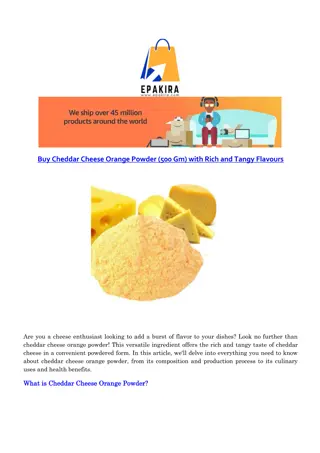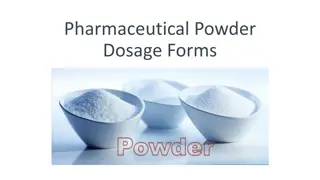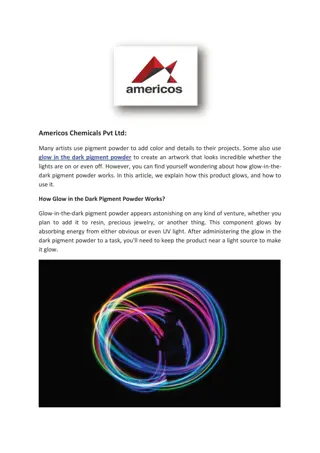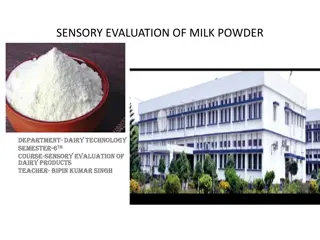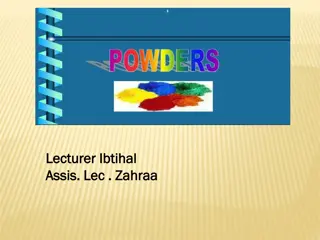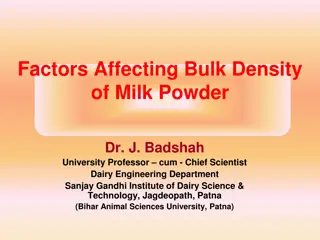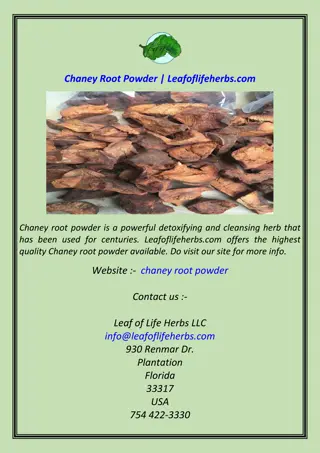
Powder Metallurgy: Production, Process, and Applications
Discover the fascinating world of powder metallurgy, a metal processing technology that creates parts from metallic powders. Learn about the PM production sequence, from compressing powders to sintering them into rigid masses. Explore the steps involved in the powder metallurgy process, from forming metallic powders to sintering and secondary processing. Delve into the production of metallic powders, including copper-base, iron-base, titanium, chromium, nickel, and stainless steel materials. Understand how particle size impacts the properties of metals in this innovative manufacturing method.
Download Presentation

Please find below an Image/Link to download the presentation.
The content on the website is provided AS IS for your information and personal use only. It may not be sold, licensed, or shared on other websites without obtaining consent from the author. If you encounter any issues during the download, it is possible that the publisher has removed the file from their server.
You are allowed to download the files provided on this website for personal or commercial use, subject to the condition that they are used lawfully. All files are the property of their respective owners.
The content on the website is provided AS IS for your information and personal use only. It may not be sold, licensed, or shared on other websites without obtaining consent from the author.
E N D
Presentation Transcript
CHAPTER SIX Powder Metallurgy 3/18/2025 Tesfa G. 1
Introduction Powder metallurgy (PM) is a metal processing technology in which parts are produced from metallic powders. In the usual PM production sequence, the powders are compressed into the desired shape and then heated to cause bonding of the particles into a hard, rigid mass. 3/18/2025 Tesfa G. 2
Introduction contd Compression, called pressing, is accomplished in a press-type machine specifically for the part to be manufactured. The tooling can be expensive, and PM is therefore most appropriate for medium and high production. The heating treatment, called sintering, is performed at a temperature below the melting point of the metal. using tools designed 3/18/2025 Tesfa G. 3
Powder metallurgy process 1. Formation of metallic powders. 2. Blending and mixing of the metallic powders in required proportions. 3. Compressing and compacting the powders into desired shapes and sizes in form of particles. 4. Sintering the compacted particles in a controlled furnace atmosphere. 5. Subjecting the sintered particles to secondary processing if needed so. 3/18/2025 Tesfa G. 4
Powder metallurgy process contd Fig. 6.1 The conventional powder metallurgy production sequence: (1) blending, (2) compacting, and (3) sintering; (a) Shows the condition of the particles, whereas (b) shows the operation and/ or work part during the sequence. 3/18/2025 Tesfa G. 5
Production of metallic powders Metallic powders possessing different properties can be produced easily. The most commonly used powders are copper- base and iron-base materials. But titanium, chromium, nickel, and stainless steel metal powders are also used. In the majority of powders, the size of the particle varies from several microns to 0.5 mm. 3/18/2025 Tesfa G. 6
Production of metallic powderscontd The most common particle size of powders falls into a range of 10 to 40 microns. The chemical and physical properties of metals depend upon the size and shape of the powder particles. There are various methods of manufacturing powders. 3/18/2025 Tesfa G. 7
Production of metallic powderscontd The commonly used powder making processes are given as follow. 1. Atomization 2. Chemical reduction 3. Electrolysis 4. Crushing 5. Milling 6. Condensation of metal vapours 7. Hydride and carbonyl processes 3/18/2025 Tesfa G. 8
1. Atomization This method involves the conversion of molten metal into a spray of droplets that solidify into powders. It is the most versatile and popular method for producing metal powders today, applicable to almost all metals, alloys as well as pure metals. Several atomization methods for producing metallic powders. Some of them are the followings: I. Gas atomization II.water atomization and III.centrifugal atomization. Tesfa G. 9
I. Gas atomization A high velocity gas stream (air or inert gas) is utilized to atomize the liquid metal. Fig. 6.2 Atomization methods: (a) and (b) two gas atomization methods Tesfa G. 3/18/2025 10
Gas atomizationcontd In Fig. 6.2(a), the gas flows through an expansion nozzle, siphoning molten metal from the melt below and spraying it into a container. The droplets solidify into powder form. In a closely related method shown in Fig. 6.2(b), molten metal flows by gravity through a nozzle and is immediately atomized by air jets. The resulting metal powders, which tend to be spherical, are collected in a chamber below. 3/18/2025 Tesfa G. 11
II.Water atomization A high velocity water stream is used to atomize the liquid metal. Fig. 6.3 Water atomization method 3/18/2025 Tesfa G. 12
Water atomizationcontd It is the most common of the atomization methods, particularly suited to metals that melt below 1600oC. Cooling is more rapid, and the resulting powder shape is irregular rather than spherical. The disadvantage of using water is oxidation on the particle surface. A recent innovation involves the use of synthetic oil rather than water to reduce oxidation. In both air and water atomization processes, particle size is controlled largely by the velocity of the fluid stream; particle size is inversely related to velocity. 3/18/2025 Tesfa G. 13
III. Centrifugal atomization It is also known as the rotating disk method The liquid metal stream pours onto a rapidly rotating disk that sprays the metal in all directions to produce powders. Fig. 6.4 Centrifugal atomization method 3/18/2025 Tesfa G. 14
2. Chemical reduction A variety of chemical reactions by which metallic compounds are reduced to elemental metal powders. A common process involves liberation of metals from their oxides by use of reducing agents such as hydrogen or carbon monoxide. The reducing agent is made to combine with the oxygen in the compound to free the metallic element. This approach is used to produce powders of iron, tungsten, and copper. 3/18/2025 Tesfa G. 15
Chemical reductioncontd Fe3O4 + 4C = 3Fe + 4CO Fe3O4 + 4CO = 3Fe + 4CO2 Cu2O+ H2 = 2Cu + H2O Another chemical process for iron powders involves the decomposition of iron penta carbonyl (Fe(Co)5) to produce spherical particles of high purity. Other chemical processes include precipitation of metallic elements from salts dissolved in water. Powders of copper, nickel, and cobalt can be produced by this approach. 3/18/2025 Tesfa G. 16
3.Crushing The crushing process requires equipments such as stamps, crushers or gyratory crushes. Various ferrous and non-ferrous alloys can be heat-treated in order to obtain a sufficiently brittle material which can be easily crushed into powder form. 3/18/2025 Tesfa G. 17
4.Milling The milling process is commonly used for production of metallic powder. It is carried out by using equipments such as ball mill, impact mill, eddy mill, disk mill, vortex mill, etc. Milling and grinding process can easily be employed for brittle, tougher, malleable, ductile and harder metals to pulverize them. 3/18/2025 Tesfa G. 18
Characteristic of metal powders The performance of powder metallurgical parts is totally dependent upon the characteristics of metal powders. Most important characteristics of metal powders are: powder particle size and size distribution, particle shape, apparent density, chemical composition, flow characteristics, and particle microstructure. 3/18/2025 Tesfa G. 19
Powder particle size and size distribution Particle size of metal powder is expressed by the diameter for spherical shaped particles and by the average diameter for non-spherical particle as determined by sieving method or microscopic examination. Metal powders used in powder metallurgy usually vary in size from 20 to 200 microns. 3/18/2025 Tesfa G. 20
Particle size influences density/porosity of the compact, mold strength, permeability, flow and mixing characteristics, dimensional stability, etc. Particle size distribution is specified in terms of a sieve analysis i.e. the amount of powder passing through 20 or 40 mesh sieves. 3/18/2025 Tesfa G. 21
Particle shape There are various shapes of metal powders namely spherical, sub-rounded, rounded, angular, sub-angular, flakes etc. Particles shape influences the packing and flow characteristics of the powders. 3/18/2025 Tesfa G. 22
Chemical composition Chemical composition of metallic powder implies the type and percentage of alloying elements and impurities. It usually determines the particle hardness and compressibility. The chemical composition of a powder can be determined by chemical analysis methods. 3/18/2025 Tesfa G. 23
Particle microstructure Particle microstructure reveals various phases, inclusions and internal porosity. Apparent density Apparent density is defined as the weight, of a loosely heated quantity of powder necessary to fill a given die cavity completely. Flow characteristics Flow-ability of metal powders is most important in cases where moulds have to be filled quickly. Metal powders with good flow characteristics fill a mould cavity uniformly. 3/18/2025 Tesfa G. 24
Characteristic of metal powderscontd Fig. 6.5 Several of the possible (ideal) particle shapes in powder metallurgy. 3/18/2025 Tesfa G. 25
Blending and mixing of the metallic powders To achieve successful results in compaction and sintering, the metallic powders must be thoroughly homogenized beforehand. Blending refers to when powders of the same chemical composition but possibly different particle sizes are intermingled. Different particle sizes are often blended to reduce porosity. Mixing refers to powders of different chemistries being combined. 3/18/2025 Tesfa G. 26
Blending and mixing of the metallic powders cont d An advantage of PM technology is the opportunity to mix various metals into alloys that would be difficult or impossible to produce by other means. The distinction between blending and mixing is not always precise in industrial practice. Blending and mixing are accomplished by mechanical means. Best results seem to occur when the container is between 20% and 40% full. 3/18/2025 Tesfa G. 27
Blending and mixing of the metallic powders cont d Fig. 6.6 Several blending and mixing devices: (a) rotating drum, (b) rotating double-cone, (c) screw mixer, and (d) blade mixer. 3/18/2025 Tesfa G. 28
Blending and mixing of the metallic powders cont d Other ingredients are usually added to the metallic powders during the blending and/or mixing step. These additives include (1) lubricants, in small amounts to reduce friction between particles and at the die wall during compaction; (2) binders, which are required in some cases to achieve adequate strength in the pressed but unsintered parts; and (3) deflocculants, which inhibit agglomeration of powders for better flow characteristics during subsequent processing. 3/18/2025 Tesfa G. 29
Compaction In compaction, high pressure is applied to the powders to form them into the required shape. The conventional compaction method is pressing. The workpart after pressing is called a green compact, the word green meaning not yet fully processed. As a result of pressing, the density of the part, called the green density, is much greater than the starting bulk density. The green strength of the part when pressed is adequate for handling but far less than that achieved after sintering. 3/18/2025 Tesfa G. 30
Compactioncontd Fig. 6.7 Steps in pressing: (1) filling the die cavity with powder, done by automatic feed in production, (2) initial, and (3) final positions of upper and lower punches during compaction, and (4) ejection of part. 3/18/2025 Tesfa G. 31
Compactioncontd As pressure increases, the particles are plastically deformed, causing interparticle contact area to increase and additional particles to make contact. Fig. 6.8 (a) Effect of applied pressure during compaction: (1) initial loose powders after filling, (2) repacking, and (3) deformation of particles; and (b) density of the powders as a function of pressure. 3/18/2025 Tesfa G. 32
Sintering After pressing, the green compact lacks strength and hardness; it is easily crumbled under low stresses. Sintering is a heat treatment operation performed on the compact to bond its metallic particles, thereby increasing strength and hardness. The treatment is usually carried out at temperatures between 0.7 and 0.9 of the metal s melting point. 3/18/2025 Tesfa G. 33
Sinteringcontd Fig. 6.9 Sintering on a microscopic scale: (1) particle bonding is initiated at contact points; (2) contact points grow into necks ; (3) the pores between particles are reduced in size; and (4) grain boundaries develop between particles in place of the necked regions. Tesfa G. 3/18/2025 34
Sinteringcontd Because PM applications usually involve medium-to-high production, most sintering furnaces are designed with mechanized flow-through capability for the workparts. The heat treatment consists of three steps, accomplished in three chambers in these continuous furnaces: (1)preheat, in which lubricants and binders are burned off; (2) sinter; and (3) cool down. 3/18/2025 Tesfa G. 35
Sinteringcontd Fig. 6.10 (a) Typical heat treatment cycle in sintering; and (b) schematic cross section of a continuous sintering furnace. 3/18/2025 Tesfa G. 36
Sinteringcontd In modern sintering practice, the atmosphere in the furnace is controlled. The purposes of a controlled atmosphere include (1) protection from oxidation, (2) providing a reducing atmosphere to remove existing oxides, (3) providing a carburizing atmosphere, and (4) assisting in removing lubricants and binders used in pressing. Common sintering furnace atmospheres are inert gas, nitrogen-based, dissociated ammonia, hydrogen, and natural gas. Vacuum atmospheres are used for certain metals, such as stainless steel and tungsten. 3/18/2025 Tesfa G. 37
3/18/2025 Tesfa G. 38
Sinteringcontd Table 6.1 Typical sintering temperatures and times for selected powder metals. 3/18/2025 Tesfa G. 39
Advantages of powder metallurgy PM parts can be mass produced to net shape or near net shape, eliminating or reducing the need for subsequent processing. The PM process itself involves very little waste of material; about 97% of the starting powders are converted to product. Owing to the nature of the starting material in PM, parts having a specified level of porosity can be made. 3/18/2025 Tesfa G. 40
Advantages of powder metallurgy contd This feature lends itself to the production of porous metal parts such as filters and oil- impregnated bearings and gears. Certain metals that are difficult to fabricate by other methods can be shaped by powder metallurgy. Tungsten is an example. Certain metal alloy combinations and cermets can be formed by PM that cannot be produced by other methods. 3/18/2025 Tesfa G. 41
Advantages of powder metallurgy contd PM compares favorably with most casting processes in terms of dimensional control of the product. Tolerances of 0.13 mm are held routinely. PM production methods can be automated for economical production. 3/18/2025 Tesfa G. 42
Disadvantages of powder metallurgy Tooling and equipment costs are high. Metallic powders are expensive. There are difficulties with storing and handling metal powders. Metal powders do not readily flow laterally in the die during pressing, and allowances must be provided for ejection of the part. variations in material density throughout the part may be a problem for complex part geometries. 3/18/2025 Tesfa G. 43




